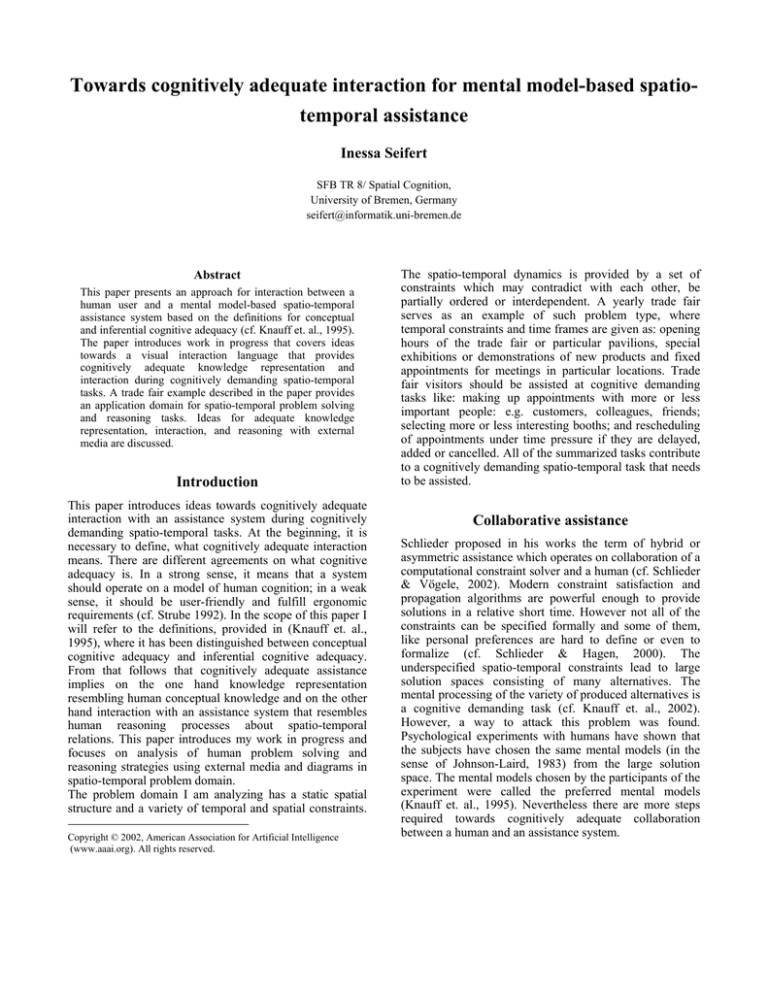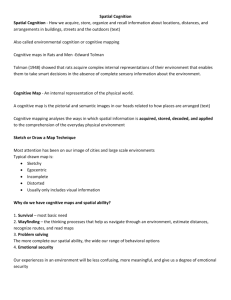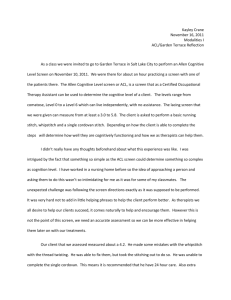
Towards cognitively adequate interaction for mental model-based spatiotemporal assistance
Inessa Seifert
SFB TR 8/ Spatial Cognition,
University of Bremen, Germany
seifert@informatik.uni-bremen.de
Abstract
This paper presents an approach for interaction between a
human user and a mental model-based spatio-temporal
assistance system based on the definitions for conceptual
and inferential cognitive adequacy (cf. Knauff et. al., 1995).
The paper introduces work in progress that covers ideas
towards a visual interaction language that provides
cognitively adequate knowledge representation and
interaction during cognitively demanding spatio-temporal
tasks. A trade fair example described in the paper provides
an application domain for spatio-temporal problem solving
and reasoning tasks. Ideas for adequate knowledge
representation, interaction, and reasoning with external
media are discussed.
Introduction
This paper introduces ideas towards cognitively adequate
interaction with an assistance system during cognitively
demanding spatio-temporal tasks. At the beginning, it is
necessary to define, what cognitively adequate interaction
means. There are different agreements on what cognitive
adequacy is. In a strong sense, it means that a system
should operate on a model of human cognition; in a weak
sense, it should be user-friendly and fulfill ergonomic
requirements (cf. Strube 1992). In the scope of this paper I
will refer to the definitions, provided in (Knauff et. al.,
1995), where it has been distinguished between conceptual
cognitive adequacy and inferential cognitive adequacy.
From that follows that cognitively adequate assistance
implies on the one hand knowledge representation
resembling human conceptual knowledge and on the other
hand interaction with an assistance system that resembles
human reasoning processes about spatio-temporal
relations. This paper introduces my work in progress and
focuses on analysis of human problem solving and
reasoning strategies using external media and diagrams in
spatio-temporal problem domain.
The problem domain I am analyzing has a static spatial
structure and a variety of temporal and spatial constraints.
Copyright © 2002, American Association for Artificial Intelligence
(www.aaai.org). All rights reserved.
The spatio-temporal dynamics is provided by a set of
constraints which may contradict with each other, be
partially ordered or interdependent. A yearly trade fair
serves as an example of such problem type, where
temporal constraints and time frames are given as: opening
hours of the trade fair or particular pavilions, special
exhibitions or demonstrations of new products and fixed
appointments for meetings in particular locations. Trade
fair visitors should be assisted at cognitive demanding
tasks like: making up appointments with more or less
important people: e.g. customers, colleagues, friends;
selecting more or less interesting booths; and rescheduling
of appointments under time pressure if they are delayed,
added or cancelled. All of the summarized tasks contribute
to a cognitively demanding spatio-temporal task that needs
to be assisted.
Collaborative assistance
Schlieder proposed in his works the term of hybrid or
asymmetric assistance which operates on collaboration of a
computational constraint solver and a human (cf. Schlieder
& Vögele, 2002). Modern constraint satisfaction and
propagation algorithms are powerful enough to provide
solutions in a relative short time. However not all of the
constraints can be specified formally and some of them,
like personal preferences are hard to define or even to
formalize (cf. Schlieder & Hagen, 2000). The
underspecified spatio-temporal constraints lead to large
solution spaces consisting of many alternatives. The
mental processing of the variety of produced alternatives is
a cognitive demanding task (cf. Knauff et. al., 2002).
However, a way to attack this problem was found.
Psychological experiments with humans have shown that
the subjects have chosen the same mental models (in the
sense of Johnson-Laird, 1983) from the large solution
space. The mental models chosen by the participants of the
experiment were called the preferred mental models
(Knauff et. al., 1995). Nevertheless there are more steps
required towards cognitively adequate collaboration
between a human and an assistance system.
Mobile multi-user and multi-device assistance
system
The concept of a mental model-based assistance system in
a ubiquitous computing environment was proposed in
(Seifert et. al., 2004). In the scope of this paper I will
provide a short overview of the concept. The proposed
assistance system operates on mobile communication
devices, e.g., PDAs and stationary table PCs or smart
boards. The devices have different visual capabilities (e.g.,
display properties), support user mobility and can
communicate with other devices over heterogeneous
networks. The basic application scenario can be described
as follows:
Our trade fair visitor arranges necessary appointments at
his office using a smart board, which provides information
about the static structure of a trade fair. After our visitor
has selected booths he/she is interested in and set priorities
and dependencies so that different alternatives can be
generated and finally one (or some) of them can be chosen.
A preliminary schedule is finished and can be stored on a
mobile device. However this is only part of the spatiotemporal problem. The proposed system assists our user in
a highly dynamic trade fair environment at setting new
priorities, rescheduling of appointments and visualizing of
alternatives in order to support our user in decision making
processes.
There exists a huge amount of sophisticated
communication devices. Although most of them have
enormous computational capacities compared to humans,
they still differ from us in interaction capabilities and
available communication channels: e.g., touch screens,
keyboards, displays and microphones. Due to interaction
limitations of supporting devices we have to find a
compromise between a technical assistance system and a
human for successful cognitively adequate collaboration.
In the subsequent sections I will introduce some ideas for
exploration studies towards interaction language between a
user and an assistance system.
Towards cognitively adequate spatio-temporal
knowledge representation
One of the requirements on cognitively adequate assistance
is a knowledge representation, which resembles human
conceptual knowledge about space. Much has been written
on internal mental spatial knowledge representation,
beginning with metaphors like cognitive maps, cognitive
collages, atlases, or spatial mental models, depending on
the field of research and the focus taken (e.g. Tversky,
1993, Hirtle, 1998). Cognitive maps are of a great help at
way finding tasks, they can barely provide information
about destinations and estimated durations. Series of
psychological experiments (cf. Klippel et. al., 2004) have
shown people tend to misinterpret distances between
connected and as well as not connected cities due to
perceptually induced distortions in cognitive maps. The
aim of my exploration studies is to find such phenomena,
where an assistance system could provide the “perfect”
knowledge about spatial constraints combining it with
cognitively adequate representation, e.g., cognitive maps.
Many research activities are concerned with spatial
knowledge representation in the field of robotics, e.g.,
route graphs (c.f. Werner et. al., 2000) or in the field of
way finding in public transport (cf. Rüetschi & Timpf,
2004). The truth lies somewhere between perfectly
computed solutions of underspecified spatio-temporal
constraints and their visual representation.
However, not only methods for cognitively adequate
knowledge representation must be considered, but also
capabilities of the assisting devices play an important part
in the interaction. From that point of view the following
research questions arise:
• Spatial and temporal constraints can be visualized in a
textual form, a diagram or both (i.e., enriched
representation). What are the preferred representations due
to visualization capabilities of digital media and how do
these capabilities, e.g., display size, available colors affect
the representation?
• What are preferred media and information artifacts (e.g.,
fair plan with extra list of appointments or just a fair plan
augmented with appointments)?
• Are there differences in choosing preferred media if one
person is involved in planning process, or the planning
task is shared between more than one people? How is
information about schedules and plans exchanged: over
texts, lists or diagrams?
Dealing with underspecified constraints many alternative
solutions that fulfill given spatio-temporal premises are
possible. The automatic generation of preferred models is
still a matter of further research. One of the methods is an
empirical study about preferred mental models and
derivation of specific rules in the given problem and
application domain.
However this paper focuses on methods and questions for
the definition of a visual interaction language between an
assistance system and a human.
Visual interaction language
First of all geometric primitives have to be identified in
order to define a set of elements, which can be assembled
to a diagrammatic, enriched representation. Although there
exist many solutions visualizing only temporal or only
spatial constraints (e.g. Hoebel et. al., 1998, Blaser et. al.,
2000), there is still a question how partial orders and
interdependencies, where both kinds of constraints must be
taken into consideration, can be visualized properly.
Tversky’s work on pictorial and verbal tools for conveying
routes (cf. Tversky & Lee, 1999) has inspired me to
employ her methods (e.g. protocol analyses, thinking
aloud) to define an interaction vocabulary for spatiotemporal knowledge representation.
Towards cognitively adequate interaction
There are different strategies to create a schedule for a
trade fair visit. One of the strategies is to arrange all
important appointments and then to analyze, what are
interesting booths and after that create a preliminary
schedule. Another one is to select interesting booths first,
compute preliminary alternative routes of visit and after
that arrange important appointments proposing the
computed durations and points in time.
My scientific questions for the exploration studies are:
• What are the strategies people are most familiar with?
• Are there differences between experts, who planed visits
many times before and novices?
• Do other strategies exist?
• How large has a spatial environment to be and how
many temporal and spatial constraints are needed, so that
some kind of strategy has to be applied?
• And the most important question: In which particular
planning tasks is assistance needed?
As I mentioned above, our visitor should be assisted not
only in an early planning stage, but also during his/her visit
to the trade fair. Further question for the exploration study
are:
• What kind of cognitive operations are needed to
reschedule one or more appointments? How many
cognitive operations are needed to understand the changes
for example in location? In time? Both?
• What is the preferred media (and channel) to
communicate the changes in the environment? How are
they visualized: text, picture or enriched representation?
Does it depend on an amount of communication partners?
• How many changes in a schedule have to be considered
in order to switch from one medium to another with larger
display size (e.g. from PDA to smart board)?
• What are the main features of information artefacts
which capture user’s focus of attention? How does
attention shifting take place? (cf. Suwa & Tversky, 1997).
The amount and kind of information provided by the
media and informational artifacts plays an important part
during the collaboration process. There are different
strategies to deal with different requirements, e.g., in the
field of architecture by focusing on specific aspects of a
problem domain (cf. Bertel et. al., 2004). Through the
proposed exploration study we can find rules how the
given application domain can be separated in different
aspects according to the spatio-temporal context of the
user.
After defining the geometric primitives and annotations
needed to express interdependencies and partial orders, a
study is needed, how this information can be understood
by the users. The work of (Seligmann & Feiner, 1991)
introduces an approach for automatic generation of 3D
illustrations for usage of electronic mass media by
formalizing a communication intent which consists of
many specific communication goals. It would be
interesting to apply a similar method and verify whether
the communication intents and the diagrammatic
representation based on elaborated geometric primitives
are understood by the assisted users in an adequate way.
Outlook and future work
In the scope of the planned exploration studies paper based
mockups that vary in size and emulate different digital
media will be used. For example different device
properties, like colored displays can be simulated with
colored pencils. For the analyses of interaction with
different media and information artifacts such methods
like: speaking aloud, audio recording and video
confrontation will be used. Subsequently the protocols of
the proposed studies will be analyzed.
This paper introduces my work in progress and therefore
provides more questions than answers. Another important
aspect is that I’m not a psychologist and the proposed
exploration (or usability) studies are not indented to be
valid from a psychological point of view. However the
results of these studies could provide interesting research
questions that would require deeper psychological
analyses.
Acknowledgments
I gratefully acknowledge financial support by the Deutsche
Forschungsgemeinschaft (DFG) through the Transregional
Collaborative Research Center SFB/TR 8 Spatial
Cognition: Reasoning, Action, Interaction (project R1[ImageSpace]).
References
Bertel, S., Freksa, C., & Vrachliotis, G. (2004). Aspectualize and
conquer in architectural design. In J. S. Gero, T. Knight, & B.
Tversky (Eds.), Visual and Spa-tial Reasoning in Design III (pp.
255-279). Key Centre of Design Computing and Cognition, U of
Sydney.
Blaser, A.D., Sester, M., Egenhofer M.J. (2000) Visualization in
an Early Stage of the Problem Solving Process in GIS. Computer
& Geosiences, Special Issue “Geoscientific Visualization”, 1,
2000.
Hirtle, S. C. (1998). The cognitive atlas: using GIS as a metaphor
for memory. In M. Egenhofer & R. Golledge (Eds.), Spatial and
temporal reasoning in geographic information systems (pp. 267276). Oxford University Press.
Hoebel, L., Lorenzen, W., and Martin K., Integrating graphics
and abstract data to visualize temporal constraints, SIGART
Bulletin, 9, 18-23, 1998.
Johnson-Laird, P. N. (1983). Mental models. Cambridge, MA:
Harvard University Press.
Klippel, A., Knuf L., Hommel, B. & Freksa C., (2004).
Perceptually Induced Distortions in Cognitive Maps, Spatial
Cognition. 2004, to appear
Knauff, M., Rauh, R., & Schlieder, C. (1995). Preferred mental
models in qualitative spatial reasoning: A cognitive assessment of
Allen's calculus. Proceedings of the Seventeenth Annual
Conference of the Cognitive Science Society (pp. 200-205).
Mahwah, NJ: Lawrence Erlbaum.
Knauff, M., Schlieder, C., & Freksa, C. (2002). Spatial
Cognition: From Rat-Research to Multifunctional Spatial
Assistance Systems. Künstliche Intelligenz, Heft 4/02, arendtap
Verlag, Bremen.
Rüetschi, U., & Timpf, S., (2004). Modeling Wayfinding in
Public Transport: Network Space and Scene Space. Spatial
Cognition 2004, to appear
Schlieder, C., & Hagen, C. (2000). Interactive layout generation
with a diagrammatic constraint language. In C. Freksa, C. Habel,
& K. F. Wender (Eds.), Spatial cognition II - Integrating abstract
theories, empirical studies, formal methods, and practical
applications (pp. 198-211). Berlin: Springer.
Schlieder, C., & Vögele., T, (2002) Visualizing Alternatives in
Spatial Planning: A Constraint-based Approach. GeoInformatics
5, pp. 36-37.
Seligmann, D.,D., & Feiner, S. (1991). Automated Generation of
Intent-Based 3D Illustrations. Computer Graphics, Volume 25,
Number 4, July 1991.
Seifert, I., Bertel, S., Barkowsky, T. (2004). Assistance for
Spatio-Temporal
Planning
in
Ubiquitous
Computing
Environments Based on Mental Models. In Jörg Baus, Christian
Kray, Robert Porzel (Eds). Workshop on Artificial Intelligence in
Mobile Systems (pp. 9-14) SFB 378, Memo Nr. 84. 2004
Strube, G. (1992). The role of cognitive science in knowledge
engineering. In F. Schmalhofer, G. Strube, & T. Wetter (Eds.),
Consteprorary knowledge engineering and cognition (pp. 161174). Berlin: Springer.
Suwa M. and Tversky B. (1997). What do architects and students
perceive in their design sketches? A protocol analysis. Design
Studies 18 (1997)
Tversky B. and Lee P. U. (1999). Pictorial and Verbal Tools for
Conveying Routes. In C. Freksa, D.M. Mark (Eds.): COSIT’99,
pp. 51-64, Springer-Verlag
Tversky, B. (1993). Cognitive maps, cognitive collages, and
spatial mental models. In A. Frank & I. Campari (Eds.), Spatial
information theory (pp. 14-24). Berlin: Springer.
Werner S., Krieg-Brückner B., & Herrmann, T. (2000). Modeling
Navigation Knowledge by Route Graphs. In C. Freksa, W.
Brauer, C. Habel & K.F. Wender (Eds.), Spatial Cognition II –
Integrating Abstract Thoeries, Empirical Studies, Formal
Methods, and Practical Applications (pp. 295-316).
Berlin:Springer. Engelmore, R., and Morgan, A. eds. 1986.
Blackboard Systems. Reading, Mass.: Addison-Wesley.




